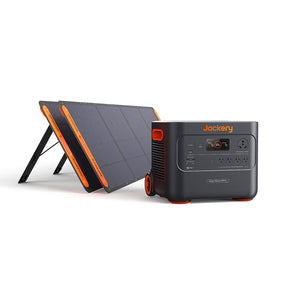If you are wondering how many watts does a TV use, the answer is simple.
If the TV amp is 1A and it is connected to a 120V outlet, the TV watts will be:
Watts = 120V × 1A = 120W.
For example, most CRT TVs draw 120 watts of electricity, plasma TVs consume 500 watts, and OLEDs consume 60 - 75 watts. The latest and most popular LCDs and LEDs consume nearly 70 - 200 watts and 50 - 100 watts, respectively. However, the exact wattage consumption will depend on the size, model, and type of TV you are using.
Jackery Solar Generators are portable, lightweight, and powerful charging solutions that can charge most types of TVs. For example, the Jackery Solar Generator 2000 Plus can charge 99% of your home appliances, including different types of TVs. On the other hand, if you're planning an outdoor movie night and want a portable power station to charge TV and other outdoor appliances, you may choose the Jackery Solar Generator 300 Plus.
Key Takeaways About TV Wattage
Here are a few essential facts about TV and its wattage.
- On average, the different models of TVs will consume around 50 to 200 wattsof electricity.
- Most modern TVs consume nearly 100 watts of power.
- A TV used for 21 hours a week will use about 75 kWh of electricity per year.
- Electricity consumed can be calculated by multiplying yearly electricity use by the average rate of electricity in your area.
- There are many factors that affect the TV watts, such as TV type, age, size, usage, and vampire power.
How Many Watts Does A TV Use?
The number of watts used by any TV will depend on its type. Here, we will include the different types of TV and their watts.
- CRT TV:These old technologies are bulky in size and consume up to 120 watts of electricity. However, many people use CRT TVs as they are great for gaming purposes without any blurry motion or input lag.
- Plasma TVs:They are made up of tiny gas pockets and light up when high voltage is applied. Plasma TV has an excellent contrast ratio and views, which consumes up to 500 watts of power.
- LCD:They are a great combination of picture quality and low power consumption. LCDs use cold-cathode fluorescent lamps for backlighting and consume around 70-200 watts.
- LED: While LCDs and LEDs use the same kind of technology, LED TVs typically use light-emitting diodes and are generally more economical.
- OLED:This latest TV uses organic light-emitting diodes and uses more power than LEDs.
The following table reveals how many watts does a TV uses depending on different sizes and types.
|
Screen size (Inches) |
LED TV Watts |
OLED TV Watts |
LCD TV Watts |
CRT TV Watts |
Plasma TV Watts |
|
15 inch TV |
15 |
NA |
18 |
65 |
NA |
|
17 inch TV |
18 |
NA |
20 |
75 |
NA |
|
19 inch TV |
20 |
NA |
22 |
80 |
NA |
|
20 inch TV |
24 |
NA |
26 |
90 |
NA |
|
21 inch TV |
26 |
NA |
30 |
100 |
NA |
|
22 inch TV |
30 |
NA |
40 |
110 |
NA |
|
24 inch TV |
35 |
NA |
50 |
120 |
NA |
|
30 inch TV |
38 |
NA |
60 |
NA |
150 |
|
32 inch TV |
41 |
NA |
70 |
NA |
160 |
|
37 inch TV |
44 |
66 |
80 |
NA |
180 |
|
40 inch TV |
50 |
72 |
100 |
NA |
200 |
|
42 inch TV |
57 |
75 |
120 |
NA |
220 |
|
50 inch TV |
72 |
89 |
150 |
NA |
300 |
|
55 inch TV |
80 |
98 |
180 |
NA |
370 |
|
60 inch TV |
88 |
107 |
200 |
NA |
500 |
How Many Watts Does A TV Use Per Hour?
The hourly wattage consumption of TV will depend on the TV type, model, and size. Here's a table revealing the power usage per hour of different types of TVs.
|
Type of TV |
Power Usage (Watts) |
|
OLED (Organic Light Emitting Diode) |
50-200 W Per Hour |
|
CRT (Cathode Ray Tube) |
60-150 W Per Hour |
|
Plasma |
100-300 W Per Hour |
|
LED (Light Emitting Diode) |
30-100 W Per Hour |
|
LCD (Liquid Crystal Display) |
50-150 W Per Hour |
How Many Watts Does A 32-Inch TV Use?
Most homeowners use a 32-inch TV because they are cheap, lightweight, compact, and easy to carry. The power consumption of same-size TVs will depend on the brand and its type. For example, a 32" LED TV will consume around 30-55 watts of power, whereas the 32" OLED uses 55-60 watts. The 32-inch LCD TV consumes higher watts, around 50-85 watts. The older 32" CRT TVs have the highest power consumption, which is equal to 150-200 watts, with an average of 170 watts.
How Many Watts Does A 55-Inch TV Use?
A 55" inch TV is the larger version of the previous models and is becoming more and more popular. Their consumption may vary depending on the TV type. For example, the 55" LED consumes around 60-90 watts, whereas the 55" OLED has a power consumption rate of 105-110 watts.
How Many Watts Does A Flat Screen TV Use?
A typical modern flat TV consumes anywhere between 50 - 150 watts of electricity. However, it may depend on the size and model of the TV. For example, if you are using a 32” LED TV, it will consume 30 - 55 watts of electricity. On the other hand, if you are using a 32” LCD TV, it might consume a higher wattage of around 50 - 85 watts.
How Many Volts & Amps Does A TV Use?
Volts and amps are the essential terms that determine how much electricity flows or is used by any appliance.
- Volts (V):It is short for voltage and typically measures the difference in electrical pressure. In other words, voltage is like the speed of electricity that passes through the circuit.
-
Amps (A):It is short for amperes and generally measures the electrical current. It is the amount of electrons that flow through the circuit.
Typically, TVs use around 120-volt outlets. If the TV amps 164W of hourly wattage, the amperage will be calculated as follows:
Amps = 164W / 120V = 1.37 amps.
How Much Electricity Does A TV Use?
On average, most TVs use anywhere between 50 - 200 watts of electricity. However, the TV watts will largely depend on the model and size of TV you have. It’s safe to say most modern TVs draw 100 watts of electricity, whereas older models might be less efficient and draw anywhere around 200W.
How Much Electricity Does A TV Use Per Month?
If we suppose you've a TV drawing 100 watts of electricity and are watching TV for nearly 2 hours per day. This calculates to 1.4 kilowatt-hour of electricity per week or 6 kilowatt-hour per month. On the other hand, if you're using the same TV for 3 hours per day, the monthly electricity consumption will be 9.1 kWh per month.
Here's how you can calculate the monthly electricity consumption of a 100W TV yourself:
Electricity or Kilowatt-hour = Watts × Usage per day × 30 = 100W × 2H × 30 = 6kWh per month.
How Many Amps Does a TV Use?
Most TVs typically consume less than one amp when connected to a 120V outlet. Let's take an example where we will calculate the amps of a TV drawing 120 watts of electricity from a 120-volt outlet.
Amps = Watts ÷ Volts = 120W ÷ 120V = 1 amps.
What Are The Factors Affecting TV Wattage?
If you are wondering about how many watts does a TV uses per hour, you'll need to understand the factors that affect the TV watts.
Type of TV: Modern TVs and LED TVs are generally more energy-efficient than older models. Generally, Energy Star-certified TVs are 25% more efficient than conventional TVs.
|
TV Types |
Power Usage (W) |
Pros |
Cons |
|
LED (Light Emitting Diode) |
30-100W Per Hour |
● They are highly energy-efficient. |
● LED TVs have less contrast and saturation. |
|
OLED TVs |
50-200W Per Hour |
● They are super-thin and have deeper colors. ● OLED TVs have sharper contrast. ● They are nearly as efficient as LED TVs. |
● OLED TVs are very expensive. |
|
Plasma TVs |
100-300W Per Hour |
● They are a superior color compared to LCD TVs. ● This type of TV has a faster response time. |
● They are only available in larger screen sizes. ● Plasma TVs use high energy. |
TV Age: Like any other technology, the older an appliance gets, the more wattage it will consume. The CRT models use up to 120 watts, whereas the LED TV consumes 24-28 watts for small sizes and 90 watts for larger sets.
Size of TV: The larger TVs typically consume more energy than smaller ones. For example, a 48-inch TV consumes 80 watts of power. But how many watts does a 65-inch TV use? It is nearly 115 watts.
|
TV Model Type |
24-inch |
50-inch |
|
CRT |
75-120 watts |
N/A |
|
Plasma |
N/A |
150-500 watts |
|
LCD |
36-44 watts |
75-90 watts |
|
LED |
24-28 watts |
50-60 watts |
|
OLED |
N/A |
90-107 watts |
TV Usage: The more TV you use, the higher the watts consumption will be. It is best to switch off the TV when not in use to avoid higher bills.
Vampire Power: It's a term for how much power any device consumes when turned off but plugged in. TVs typically consume 5% of their usual power consumption, even in standby mode.
How to Determine The TV Power Consumption?
Most modern TVs, like LED or OLED, are more energy-efficient and have an ENERGY STAR-rated sign. It generally consumes around 150 watts. You can find the TV power consumption on the blank panel of the appliance. If, in case, you cannot find the wattage on the TV, multiply the maximum TV voltage and amperage.
Formula: Watts of TV × Hours Used = Power Consumption
Example: A 150-wattage TV appliance, when used for three per day, will consume 150W × 3H = 450Wh per day.
Jackery Solar Generators for TV
55% of Americans spend around one to four hours watching TV, whereas 22% of people watch TV for more than four hours every day. Investing in a solar generator is one of the best ways to reduce the high electricity bills. It runs on the free solar energy that gets converted to electricity. With Jackery Solar Generators, you can charge TVs and even high-power-consuming appliances for long hours.
Jackery Solar Generator 3000 Pro
If you want a large solar generator that can charge most household appliances, including most TV models, the Jackery Solar Generator 3000 Pro might make more sense. It has double wheels, pull rods, and a foldable handle to move the portable power station from one place to another.
Appliance running time:
TV (50W) = 51.4H
Large TV (200W) = 12.8H
Projector (100W) = 25.7H
LED lights (5W) = 514H
Smart Speaker (20W) = 128.5H

Jackery Solar Generator 2000 Plus
The Jackery Solar Generator 2000 Plus is an ideal solution for indoor and outdoor adventures. If you're planning an outdoor movie night or camping trip, you can bring the solar generator with you. It can also help you supply steady power to other outdoor appliances, such as electric grills, freezers, etc. It can even be expanded from 2kWh to 24kWh, so you can use it for emergency home backup solutions.
Appliance running time:
TV (50W) = 34.7H
Large TV (200W) = 8.6H
Projector (100W) = 17.3H
LED lights (5W) = 347.2H
Smart Speaker (20W) = 86.8H

Jackery Solar Generator 1000 Plus
The Jackery Solar Generator 1000 Plus is another power solution that's capable of charging most appliances during power outages or outdoor adventures. The multiple output ports help you charge other appliances, including lights, mobile phones, laptops, CPAP machines, etc. Its compact size, ergonomic design, and large capacity make the solar generator an ideal choice for most activities.
Appliance running time:
TV (50W) = 21.4H
Large TV (200W) = 5.3H
Projector (100W) = 10.7H
LED lights (5W) = 214.8H
Smart Speaker (20W) = 53.7H


How Much Does It Cost to Power A TV?
The monthly electricity bill has the total amount you're charged and not how much each home appliance contributes to the bill. The following table reveals the cost of running a TV monthly and yearly.
|
State |
Average Electricity Rate |
Cost Per Month |
Cost Per Year |
|
California |
22.00 ¢ / kWh |
$2.01 |
$24.09 |
|
New York |
20.59 ¢ / kWh |
$1.88 |
$22.55 |
|
Texas |
12.56 ¢ / kWh |
$1.15 |
$13.75 |
|
Massachusetts |
22.59 ¢ / kWh |
$2.06 |
$24.74 |
|
Florida |
12.21 ¢ / kWh |
$1.11 |
$13.37 |
|
Virginia |
12.58 ¢ / kWh |
$1.15 |
$13.78 |
|
New Jersey |
16.20 ¢ / kWh |
$1.48 |
$17.74 |
|
Maryland |
14.48 ¢ / kWh |
$1.32 |
$15.86 |
|
Washington |
10.38 ¢ / kWh |
$0.95 |
$11.37 |
|
US Average |
14.19 ¢ / kWh |
$1.30 |
$15.54 |
Source: Electric Power Monthly - U.S. Energy Information Administration (EIA)
If you want to calculate the electricity usage of a TV, all you need to do is multiply the annual kWh and the electricity cost divided by 1000 hours of usage.
LEDs require more than standard direct-lit and edge-lit type LCD TVs. On the other hand, OLEDs are more power-hungry than the average LED models. The OLEDs and LEDs consume twice as much power compared to the older plasma TVs.

Not only does the power consumption of a TV scale with size, but it also gets affected by the brightness. When you raise the brightness level progressively, it leads to higher consumption and higher costs. Reducing the brightness level of the TV by 50% does not necessarily halve the energy use, as other TV parts also consume some energy.

TV Wattage FAQs
What size of solar generator do I need to run a TV?
The size of the solar generator required will directly depend on how many watts does a TV uses. For example, if the TV consumes 50W of power and you wish to charge it using the Jackery Solar Generator 3000 Pro, the working hours can be calculated as:
Working Hours = Battery Capacity in Wh × 0.85 / Operating wattage of TV = 3024Wh × 0.85 / 50W = 51.4H.
Does TV use a lot of electricity?
On average, TVs consume around 62 kWh per annum. Compared to other household appliances, TVs fall in the middle in terms of energy consumption.
How much electricity does a TV use when off?
Most of us believe that turning off the appliance means it won't be consuming any kind of power. However, that's not true. When you turn off the TV using the remote, your appliance starts working in standby mode. A TV in standby mode typically consumes 2.25-5% of the power used when the appliance is on.
How to reduce the TV power consumption?
There are many ways to reduce the power consumption of TV. Here are some tips:
- Do not leave the TV on when not in use, and make sure you disconnect it entirely from the power source.
- Use a surge protector or smart power strip to automatically cut power to the TV when it is not in use.
- Invest in energy-efficient TV models like the ones with Energy Star ratings.
What's the best time to run a TV?
There is no right or wrong time to run a TV. However, using appliances like TVs during off-peak hours (usually overnight) is generally more affordable.
Final Thoughts
How many watts does a TV use depends on the technology, size, and type. For instance, the newer and energy-efficient models like OLED TVs and LEDs draw less electricity compared to older Plasma and CRT models. As a general rule of thumb, the power consumption will increase when the screen size increases.
If you want to reduce the overall power consumption, you can use energy-efficient features, adjust settings, or use a portable power station. Jackery Solar Generators are reliable charging solutions that can power most TV units and even other household appliances. Thus, you can reduce the overall monthly electricity bill.














































































































































![How Many Watts Does a TV Use: 24, 32, 50, 55, 65 Inch TV and More [With a Data Table]](http://www.jackery.com/cdn/shop/articles/how_many_watts_does_a_tv_use_by_jackery.jpg?v=1704263616)







Leave a comment